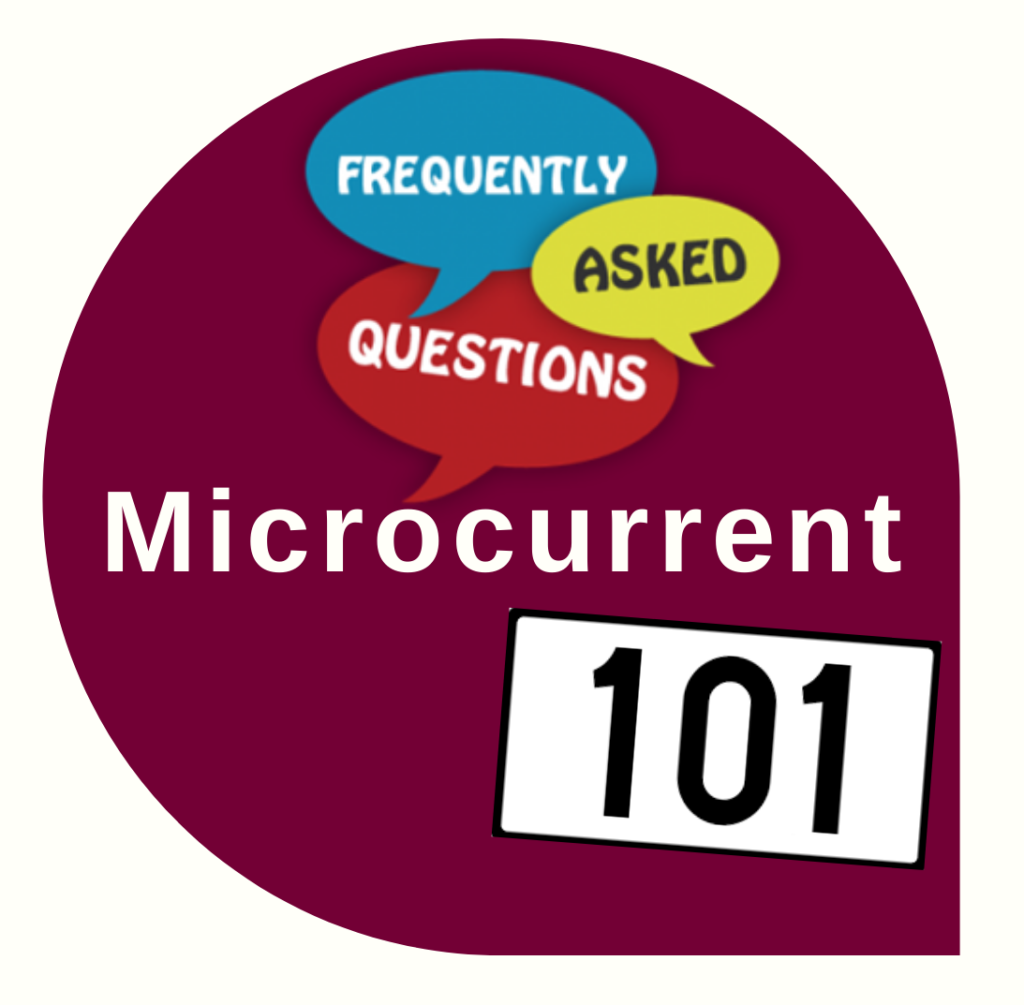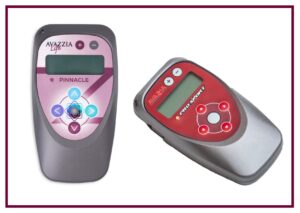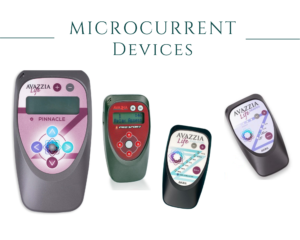
Whether you’re a microcurrent novice or guru, you may have some questions about this cutting-edge healing technology. If you’d like to get the 4-1-1 on microcurrent therapy, please allow us to help. In this blog post, we provide the answers to some of the frequently asked questions our doctors get.
Microcurrent pro? Suppose you already know a lot about microcurrent. In that case, this is a great article to pass along to your clients, friends, or family to introduce them to this simple yet revolutionary approach to chronic pain management (and so much more).
What Does Microcurrent Therapy Do?

Microcurrent is a form of energy medicine. Basically, it is a way to relieve pain using gentle yet powerful levels of electrical current. This treatment option can be performed at home or in a practitioner’s office and is applied to specific tissues in your body to help with pain caused by injuries or medical conditions.
What else can microcurrent do?
A lot! Aside from relieving chronic and acute pain of all kinds, microcurrent therapy has helped thousands of people with nerve troubles, muscle issues, emotional and physical trauma, non-healing wounds, aching joints, scars, autoimmune disease, sagging or dull skin, mental health issues, weak muscle tone, stress, headaches, insomnia and more.
What can’t microcurrent do?
Microcurrent therapy has been a godsend for so many people, but believe it or not, there are actually some things it can’t do. Read our blog here to learn more.
What is Frequency Specific Microcurrent? How is it Different From What We Do?
Functionally FSM (or frequency-specific microcurrent) is a way to relieve pain using extremely low levels of electrical current, typically delivered through two channels to stimulate the body with two different frequencies simultaneously.
So, how is this different from our Avazzia devices?
FSM machines are often big, bulky, and require the adjustment of knobs and dials to effectively change the current output to your needs during and throughout treatment. These devices often also use towels and water to conduct the electricity effectively.
Our devices operate at a high voltage, which doesn’t mean they’re dangerous (or painful). The current gets pushed deeper and faster into the tissue at a depth that FSM simply can’t manage.It also means that we can work on deeper issues than those on the body’s surface.
Furthermore, though the body responds well to specific frequencies, it needs change to break through barriers in the body.
“As a result, as our devices treat the body, they run on algorithms that automatically change those dials and adjust those settings, not only removing the complexity and learning curve of FSM but also delivering superior results by getting the body’s attention, getting in deeper to make lasting change, and breaking down barriers to healing in a way that FSM simply cannot manage.”
-Dr. Rob Vanbergen DNM Phd
Microcurrent vs. TENS—What’s the Difference?
If you’ve heard about using electricity for pain reduction and healing, you’ve most likely heard of a TENS device. But don’t confuse TENS with microcurrent technology—they aren’t the same.
Microcurrent devices differ widely from conventional types of electric stimulation. The impulses delivered by microcurrent are about a thousand times less intense than those provided by a TENS device.
TENS units operate at such high power that they virtually paralyze pain pathways to block the pain signal. These pain blocks may feel great at first but are only temporary.
So yes, both TENS and microcurrent use electricity to promote healing. But microcurrent is the only electrical treatment that uses the same range of frequencies as the body, triggering long-lasting results.
Microcurrent devices are also designed to be used with greater precision than TENS devices and often include probe electrodes suitable for treating acupuncture and trigger points in addition to the standard electrodes.
Who Can Benefit from Microcurrent Therapy?

Practically anyone! Microcurrent is known for its profound ability to address chronic pain, inflammation, autoimmune symptoms, wounds, mental health conditions, and more due to its ability to promote regeneration and healing at a cellular level.
To learn how you, your kids, your pets, and practically anyone you know can use microcurrent therapy to improve their health, please read our blog post, The Top 5 Reasons to Use Microcurrent Therapy.
Who Should Not Use Microcurrent?

If you have problems related to the brain, a pacemaker, or are pregnant, you should approach microcurrent only with explicit approval from your doctor.
How Long Has Microcurrent Therapy Been Around?
Microcurrent is a revolutionary treatment that many consider a “new” approach to addressing chronic pain and more, but did you know the origins go all the way back to Hippocrates and the ancient Egyptians? Back then, the treatments they designed were more akin to a TENs unit and utilized electrical eels. Shocking, right?!
Luckily, we’ve progressed to a much more sophisticated and elegant method of harnessing the power of electricity for healing.
- In the 1960s., Dr. Ronald Melzack and his colleague, Dr. Patrick Wall, created the Gate Control Theory, which stated that AC stimulation effectively blocks pain impulses to the brain.
- In the 1970s, Dr. Bruce Pomeranz found a new application for microcurrent devices that utilized direct current to trigger beta-endorphins released through the pituitary gland.
- Jump to the 1980s; physicians would first use microcurrent in Europe and the US to stimulate bone repair in non-union fractures.
Today, the mainstream use of microcurrent therapy for healing is an accepted procedure among orthopedic surgeons and is approved by the FDA for treating depression, anxiety, and insomnia. Medical doctors, acupuncturists, chiropractors, physical therapists, veterinarians, natural healers, and everyday people rely on this technology to consistently improve the outcome of healing.
Does Microcurrent Therapy Hurt?
Nope! Microcurrent therapy is entirely painless (many of our patients find it incredibly relaxing). Most people don’t feel a thing when receiving microcurrent therapy, and the ones that do report a slight tingling sensation.
Is Microcurrent Therapy Effective?
If you’ve ever checked out our Pain Free For Life Support Group, or success stories, you know that microcurrent is highly effective in a wide range of applications, from facelifts to non-healing wounds. Microcurrent presents a viable solution to most common health conditions and concerns and has been extensively tested in various clinical trials and studies to great acclaim.
How Long Do the Effects of Microcurrent Last?
Microcurrent therapy has both cumulative and instant benefits – ultimately, your results and their duration will depend on how severe your condition is and your individual constitution. But it is not out of the realm of possibility to see substantial improvement in as little as one session!
Does Microcurrent Have Side Effects?
The best part of microcurrent therapy is that it lacks the side effects of traditional pain treatments like painful injections, long recovery periods, or invasive surgeries. Best of all, microcurrent is not habit-forming. Still, it’s always best to consult with your primary care physician before embarking on any new health regimen or treatment.
Is Microcurrent More Expensive than Conventional Medicine?
Most conventional pain treatments are surprisingly cost-prohibitive. Pain patients and their families are often left to endure severe financial distress because of the ongoing cost of prescription drugs, hospital stays, doctor visits, and various other therapies.
The cost of long-term medical treatment for pain can deal a devastating blow to household budgets and drain nest eggs QUICK. Chronic pain sufferers often experience bankruptcies and other financial hardships, which only adds to the mental burden of pain, creating even more stress—making their condition worse. You can see how a vicious downward spiral ensues.
Unfortunately, conventional medicine’s approach to pain is sadly inadequate. Rather than identifying and remedying the actual source of pain, traditional medical treatments attempt to eradicate it at any cost.
Remember, “cost” is not just a financial concept. The conventional medical system can drain you of riches like peace of mind, familial relationships, confidence, and quality of life. These resources are priceless and should be guarded dearly.
When considering the cost of investing in microcurrent technology for your chronic pain, remember how much more expensive it can be to stay on the merry-go-round of conventional pain treatments. Microcurrent therapy aims to solve the problem and free you from the restrictions of chronic health problems, not keep you dependent on it.
Which Microcurrent Device is Right For Me?
 With so many microcurrent devices on the market, you may be wondering how to figure out which one is the best for your individual health needs and goals. If this is the case, you’re in luck. We recently posted an informative blog about how to select the right machine for you. In it, you’ll find all kinds of resources like videos, links to additional relevant blogs, and a handy microcurrent device comparison chart to make your decision-making process a snap.
With so many microcurrent devices on the market, you may be wondering how to figure out which one is the best for your individual health needs and goals. If this is the case, you’re in luck. We recently posted an informative blog about how to select the right machine for you. In it, you’ll find all kinds of resources like videos, links to additional relevant blogs, and a handy microcurrent device comparison chart to make your decision-making process a snap.
Questions? Concerns?
Browse our Sana Shop online. Here you’ll find many products (like microcurrent therapy devices) that have been screened by the doctors at Pain Free for Life for quality and efficacy and authorized for use with the Hache Protocol for Pain Resolution™. Aside from microcurrent devices, we also offer a variety of accessories, books, wellness devices, supplements, and more.
Join Our Free Pain Free for Life Support Group on Facebook. This FREE support group is available for anyone to join and receive encouragement, tips, and advice on managing pain naturally and effectively using the Hache Protocol for Pain Resolution.
Contact us today if you have any questions that we didn’t address in this blog post. We’d love to help!





